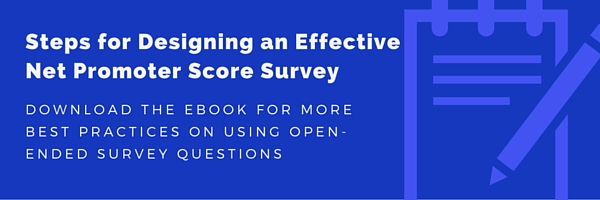From determining the appropriate amount of questions to ensuring an accurate sample size, designing a B2B customer satisfaction survey involves many important decisions. And one of the first choices you will face during this process is deciding what types of questions, including open-ended and closed-ended questions, to include in the survey.
The most effective customer satisfaction surveys include an assortment of question types in order to obtain different sets data. Scale, ranking, and multiple-choice questions are just a few examples of closed-ended questions. They gather a significant amount of reliable data for your organization. However, selections are limited to only your pre-populated response options.
On the other hand, open-ended survey questions offer customers the opportunity to expand on their feelings regarding your company. For these questions, maximum character count is the only limitation placed on respondents.
The Value of Open-Ended Survey Questions
One of the main purposes of including open-ended questions in your survey is to identify trends that lead to improvement. Think about it. Customers generally only take the time to submit feedback in open-ended questions when they are passionate or feel strongly. That’s because it is quicker (and easier) to select a scale option.
Marrying the qualitative and the quantitative data will tell a powerful story that should drive positive change. Therefore, companies must incorporate the themes found in open-ended survey responses to establish improvement priorities for (1) that customer in particular (closed loop), and for (2) the company overall when the feedback they submit is also shared by others.
Challenges with These Survey Questions
One of the disadvantages some companies face when using open-ended survey questions is the inability to convert the sentiment shared into something meaningful by distilling it down to prominent themes and making it actionable. To overcome these analytical and reporting challenges, you can manually categorize responses (positive and negative) into a codebook or rely on companies that offer text analytics tools.
But the drawback with text analytics software is that it can be costly, complex, and generally requires thousands or tens of thousands of comments to be effective. To fully harness the power of open-ended feedback, we believe you must apply the human touch. Unfortunately, distilling down insights, organizing responses, and quantifying sentiment in-house can deplete already stretched resources. This is one role we play – analyzing and quantifying large amounts of unstructured data.
Different Ways to Leverage Verbatim Feedback
Despite these obstacles, open-ended survey questions are ideal for generating a vast amount of honest feedback, especially in the B2B world. Beyond identifying improvement initiatives, how can your company take advantage of individual respondents’ opinions and experiences?
1. Reward and recognize employees called out in positive responses. This can be handled by (1) pointing out employees during company meetings, (2) posting actual quotes on a monitor in your break room, or (3) acknowledging employees on your intranet. Additionally, a pattern of praise for a specific employee or department is obviously a strong indication that customers are happy. What specifically do customers consistently rave about? Use this information to duplicate success across the organization. In contrast, repeated complaints about a person or department can become a valuable resource in identifying prevalent issues facing the organization. Focus this information on retraining employees.
2. Share valuable feedback with the Marketing department. Smart marketers are always looking to expand the list of customers who love the company. Positive quotes found in open-ended survey questions can easily make excellent testimonials or even lead to the creation of case studies, videos, and other marketing assets. The feedback from satisfied customers can also become valuable stories for your website and social media accounts. One caveat – your company needs to get approval for attribution before using quotes. That’s because respondents provide feedback with the assumption (and implicit understanding) their input is for internal use only. You or your marketing team can speak with the respondent, thank them, and invite them to participate in your marketing efforts.
3. Arm the Sales department with priceless customer insights. What elements of your value proposition resonate with customers? For example, do customers always compliment a certain product feature or benefit? The sales team is always in need of talking points that will help them convert opportunities into sales. And comments found in open-ended survey questions can shed light on aspects of your products or services that consistently delight your customers. Give your sales team this information so they can emphasize them in their sales pitches.
4. Offer the feedback to the Human Resources department. What qualities do customers appreciate most about your employees? For example, if proactiveness is a common theme, HR specialists can tailor their hiring practices to what your customers value. Conversely, the feedback can help you avoid hiring people with qualities customers dislike about your company. Additionally, your HR department can use the most common attributes found in open-ended survey questions to structure variable compensation plans.
Let’s Recap
Including open-ended questions in your customer satisfaction survey is one of the most effective ways to generate authentic and unique feedback about your products, services, and people.
Use candid customer opinions to celebrate employees who emulate positive personality traits. Coach others on how to take advantage of this wealth of information. Use this feedback to improve hiring practices. Like many world-class organizations, you may find that your efforts result in enhanced business performance.
To learn more about analyzing responses found in open-ended survey questions, download our EBook: Steps for Designing an Effective Net Promoter Score Survey.


